Stitching has long been associated with ‘repairing,’ especially in the domestic arena. Holes in socks get darned, threadbare clothing is reinforced with patches and needlework, and stains on tablecloths are hidden with decorative embroidery.
While much of that repairing is indeed functional, there is also a surprising artistic grace to many of those repairs. And that’s exactly what textile artist Shelley Rhodes’s seeks to capture in her own ‘repaired’ textile art.
Shelley purposely deconstructs fabrics, papers and more solely for the opportunity to piece and reconnect them together again. And it’s all very exciting! Using techniques inspired by Kantha and Japanese Boro, Shelley masterfully preserves the original intent of the materials used, as well as layering and positioning them in ways that also give the materials new meanings.
Shelley also describes her sketchbook process and her love for exploration. Nothing is off the table when it comes to her ‘methods of repair’ (including metal, plaster and nails). Her purposeful experimentation is as exciting as her final works. You’re sure to be inspired.
Shelley works from her studio on the Cumbria/Lancashire border in the north of England. She is a member of the Textile Study Group and author of two Batsford books. Her latest book [easyazon_link identifier=”1849946108″ locale=”UK” tag=”wwwtextileart-21″]Fragmentation and Repair will be published in August, 2021.
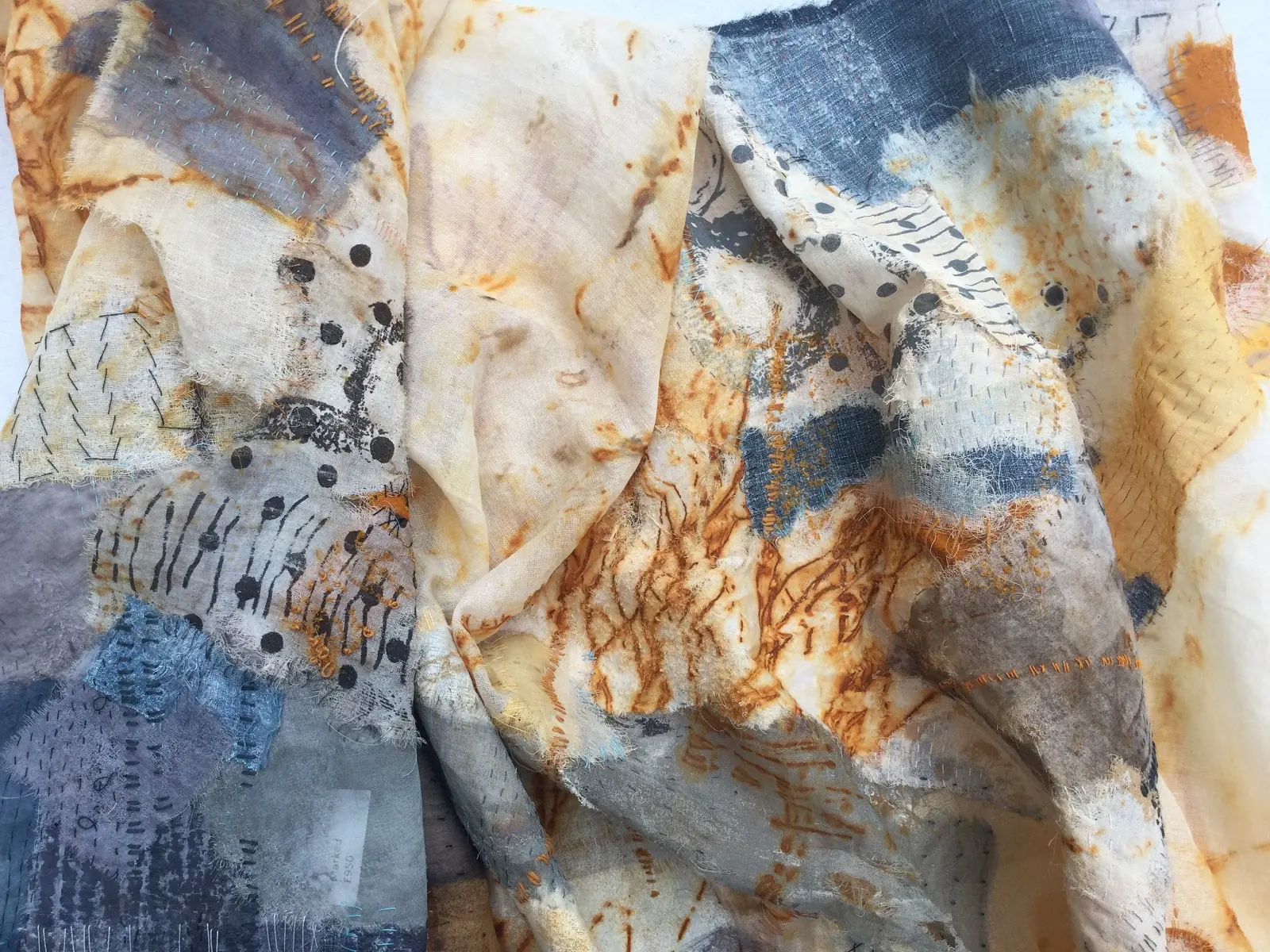
The call of collage
TextileArtist.org: What initially attracted you to textiles as a medium? How was your imagination captured?
Shelley Rhodes: I was attracted by how beautiful, tactile and intriguing textiles could be. But once I started making, I realised how flexible this medium was. Even when things do not work out as planned, they can be altered, added to, or sections can be erased, covered or hidden.
It is also possible to use the reverse side, cut out, reinsert, rotate, and thus, completely change a piece.
I like to revisit old work and reconfigure it in some way. I also enjoy combining my love of drawing with stitched marks.
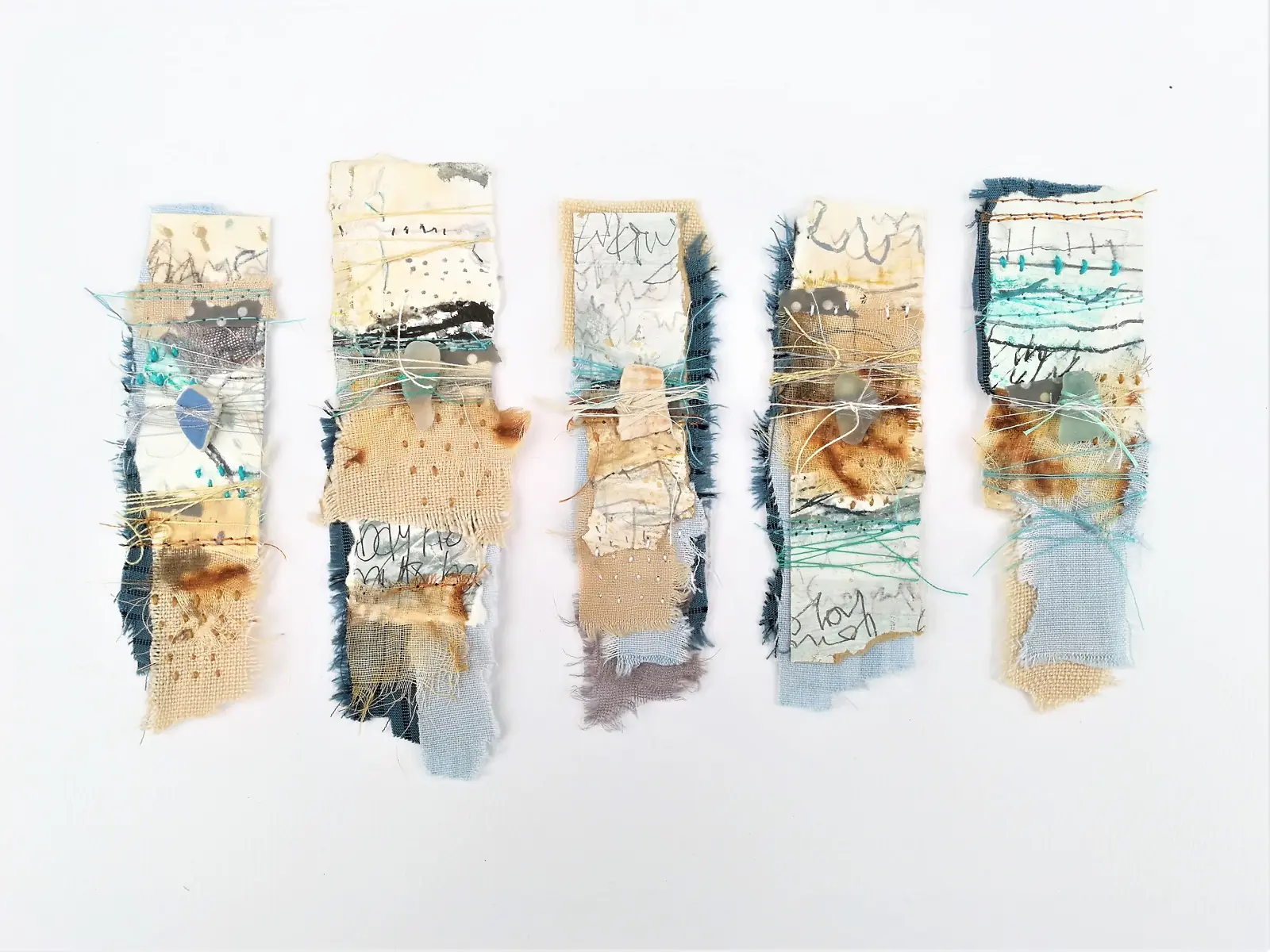
What or who were your early influences and how has your life/upbringing influenced your work?
I am not a textile artist who stitched from an early age. In school, I made a few functional items, such as an apron, but I never made any textile art until I was training to become an art teacher. I remember the excitement of rummaging around in huge bins of fabric remnants, carefully selecting and arranging small pieces to create my first piece of textile art.
However, as a child, I always loved art. And I particularly enjoyed cutting up magazines and sticking—perhaps the very early beginnings of my ongoing interest in collage.
My mum has always been interested in art and wanted to pursue an artistic career, but she was told ‘to get a proper job.” So, she was very supportive of my decision to go to art college.
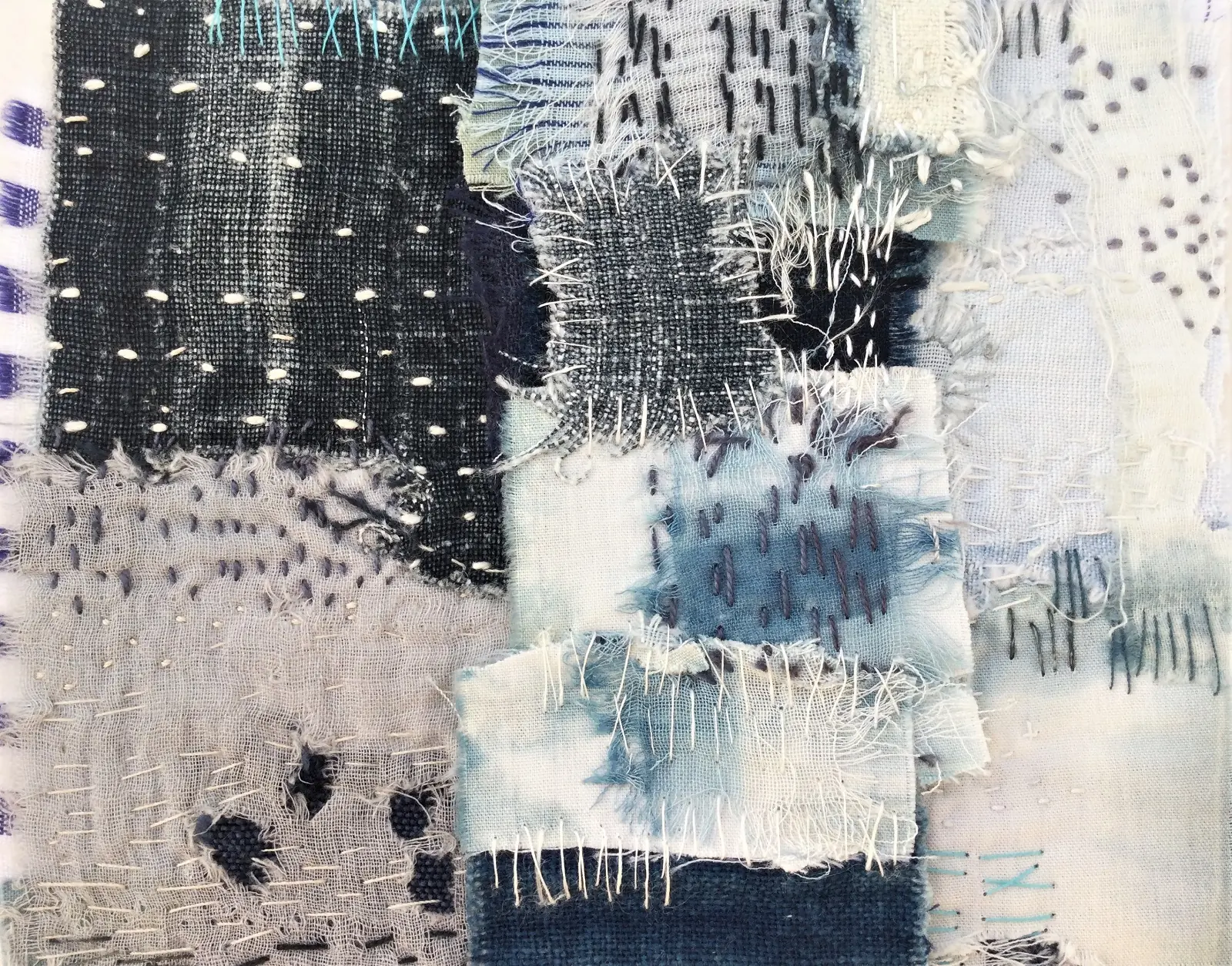
What was your route to becoming an artist?
I completed an Art Foundation course at Liverpool Polytechnic (now John Moores University) straight from school, followed by a B.A.Hons. in Graphic Design at the same school.
I worked as a graphic designer in the television industry for about seven years before studying for a Post Graduate Certificate in Education at Manchester Metropolitan University. I worked as a secondary teacher before becoming a full-time artist. I also started to teach adult workshops alongside my own practice.
Teaching helps me explore, test and sample widely and thoroughly, as I like to make stacks of samples before I teach. Some of these feed into my own work.
Exploration, investigation and teaching go hand in hand. Nearly every time I teach, I learn something from a student—it may be discovering a new artist, book, technique or type of media or material I haven’t come across. I love that generosity of sharing within a class.
When a move to another part of the country with my husband’s job meant I had to leave my full-time teaching job, it seemed like a natural time to become a ‘full time artist’ (well, mostly full time, alongside some admin work for my husband’s business). It didn’t really feel like I took a leap, as the opportunity came up, and I was ready to embrace it.
I took things slowly, letting my artwork, teaching and business evolve and grow. I like how ‘one thing leads to another’ and opportunities often arise from the things you do and sometimes by chance if someone sees my work in a gallery, online or attends a class. For instance, I was invited to teach in Australia because the organiser had seen my work on Pinterest.
Although I do apply for things, some of the most exciting opportunities come about in other ways.
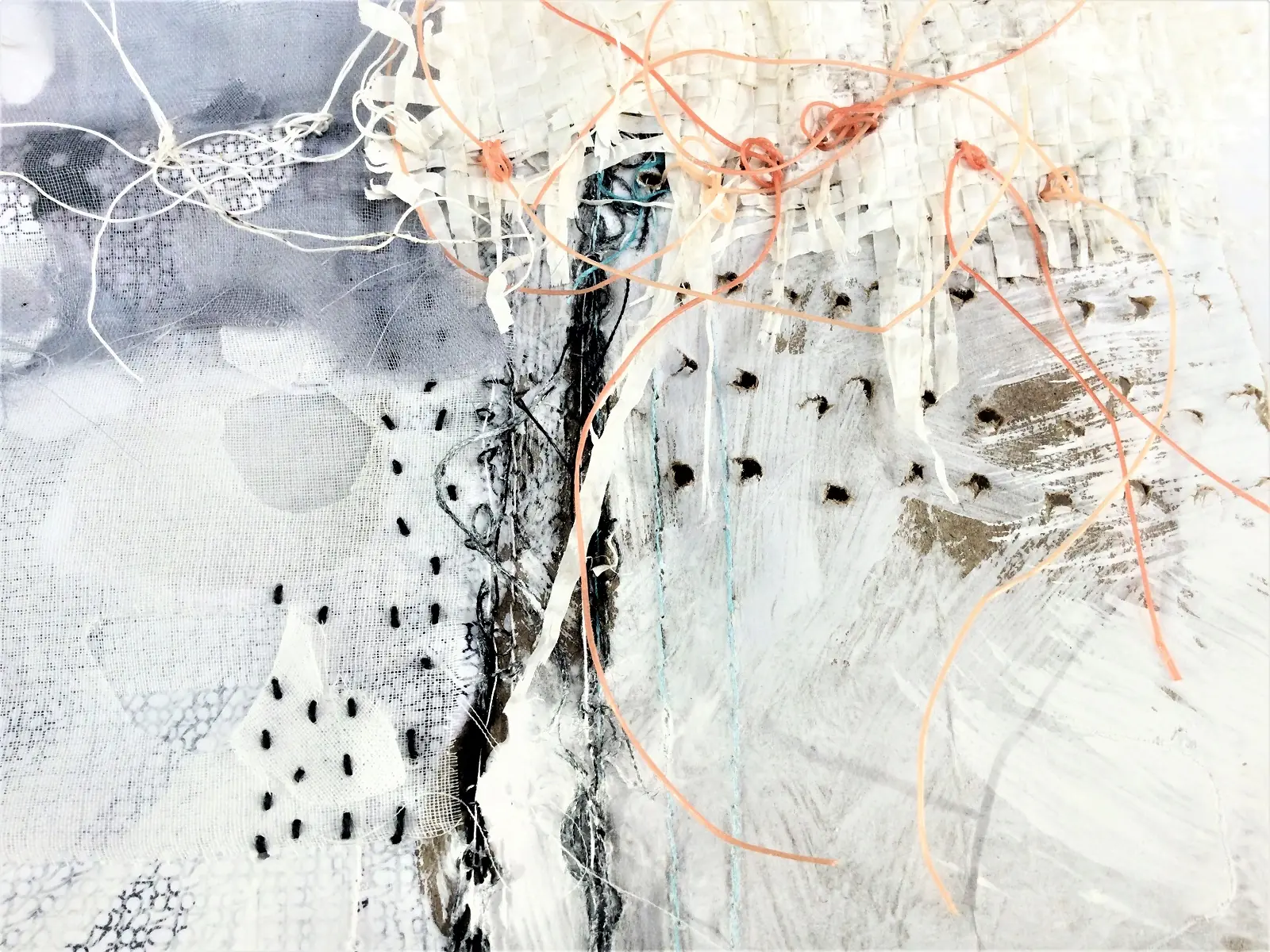
Seeking imperfection
Tell us about your process from conception to creation
My work is often inspired by a collection of artifacts. These are usually ordinary, mundane things that have been found or salvaged. They are often worn and weathered, imperfect, fragments of little importance. I observe closely and investigate through drawing, mark-making, extracting detail, printing, photography and image manipulation.
Fleeting ideas may lead to a quick drawing, scribbled notes or list of words. Text relating to the objects, the story behind them or messages that I want to convey may be incorporated into my drawings and collages. Often this is ‘asemic’ writing: illegible handwritten scribbles that form another layer of marks. Occasionally, I also make a print plate or stamp block lettering.
I explore many ideas and keep them all together in an A3 workbook. I like this size and format as it allows me to go back to one place to revisit and follow up on earlier ideas. I pin samples and test pieces in there, along with notes, sketches and diagrams. I also use it as a place to experiment and explore materials and colour combinations.
I work in spiral bound sketchbooks, so I am able to just snip the pages out.
In a similar way, I use a pin board, but my workbook keeps everything together as a record of my progression, whereas things on my pinboard are constantly being moved and replaced.
I start sampling, exploring, testing and making before deciding what to take forward, what to reject or what to push in a new direction. I love this exploratory process and could quite easily just do this and never make the finished pieces.
I also often make my own drawing tools, and if there is something within my original collection that can be used to make a mark, then I like to use that, as it creates a connection between the original source and the drawing.
I make very simple printing plates [from recycled packaging] that can be used to make multiple marks. And I often go back to simply using ink and a stick found on location. This makes slightly irregular, unpredictable marks.
Once filled, I keep and refer back to my workbooks and follow up on ideas years later. But I also keep small daily sketchbooks. These used to just get stacked on my shelves and come out occasionally for workshops and open studios.
I was asked many times if my sketches were for sale, but I had worked both sides of the page, making them difficult to sell. So, starting in 2021, I began working on just one side of the page, and now all of my daily artwork is available for sale. Sketches are posted each day on Instagram.
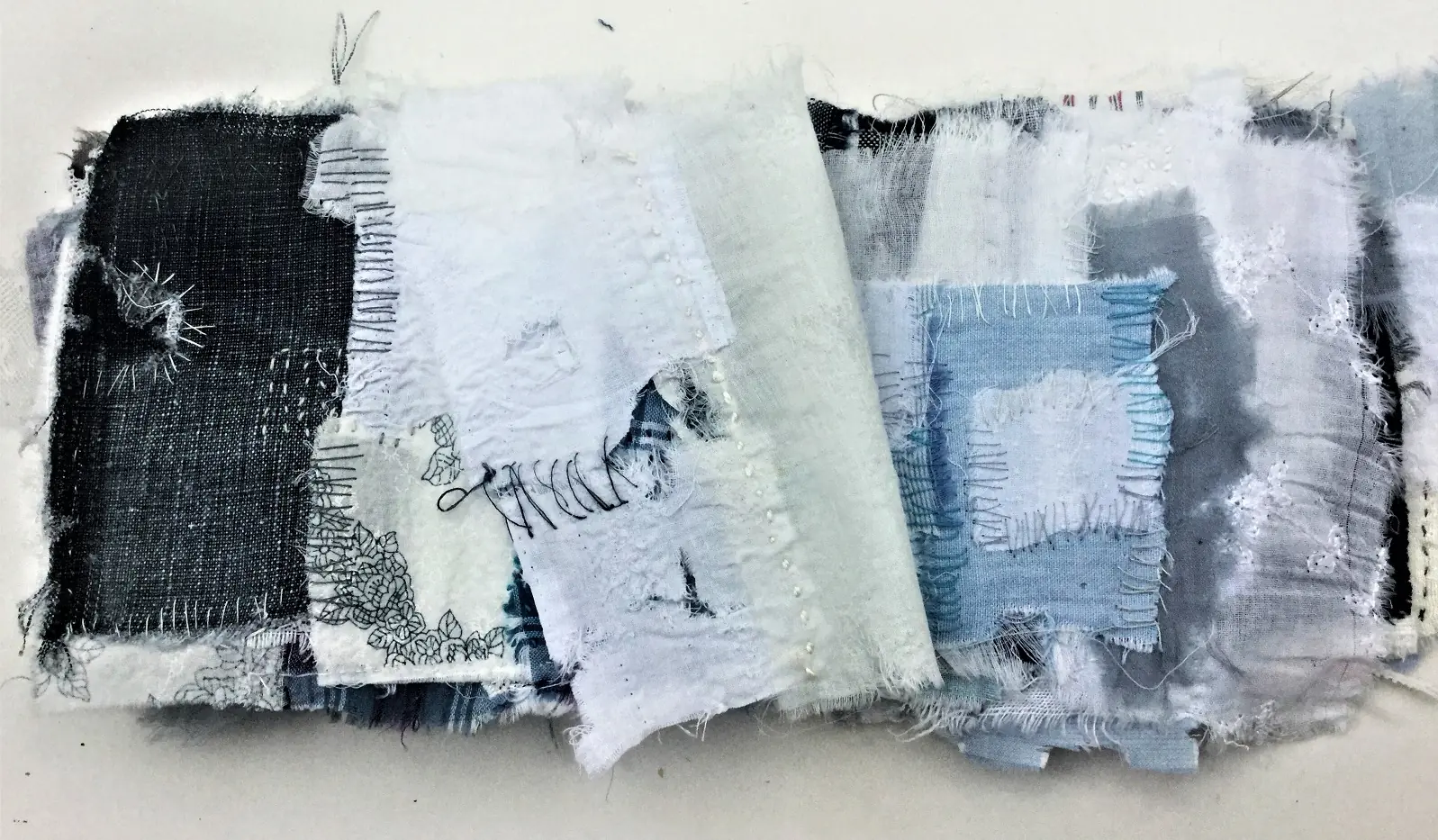
Tell us a bit about your chosen techniques and how you use them
For many years, I have been drawn to worn and weathered, surfaces, structures and objects. I like imperfections, tears, holes—things that are broken or incomplete. I realized many years ago that what I do most of the time is fragment fabric and paper into smaller pieces and then reconstruct or ‘repair’ them back together.
Even when a piece of work is nearly complete, the act of breaking, tearing or fragmenting the piece and then putting it back together can make it look so much more exciting. I often do this with drawings and sketches, as well as stitched work.
I also keep all fragments, offcuts and leftovers from any project, and these scraps are often used in new work.
Like many mixed-media artists, I have stacks of materials—different fabrics, paper, wire, threads, as well as many different types of drawing and painting media. So, for each project, I have to select what to use.
This often involves lots of sampling and testing. These are usually pinned into my workbook alongside notes. Some materials and techniques work better together than others, so I test and explore. It is a chance to push things to see how far I can go. Not everything will work, but it is well worth trying. Always say ‘what if…,’ and then try it.
In terms of fabrics, I often use pre-used cloth. I like the softness, worn areas, holes, mends and gently faded colours. It has a different quality to newly manufactured cloth, and I feel re-using is better for the environment and can save money.
I cut up and reuse old garments, bed linen, table cloths etc. I scour charity shops as well as recycling my own clothes. I generally like to work with natural fabrics, but not exclusively. I buy some fabric, usually cotton organdie and silk organza. I often work in layers so working with these lightweight, sheer fabrics allows the layers beneath to show through.
As with cloth, I often use recycled papers. I use pages from old books, ledgers and documents, as well as all kinds of packaging and envelopes. Similar to the fabric I purchase, the papers I buy, tend to be lightweight papers for layering, such as abaca tissue, modelspan, tea bag paper, rice paper, deli paper and Japanese papers.
Once something has been fragmented or deconstructed, I then reconstruct the small pieces, Of course, things can be put back together and ‘repaired’ using stitches, but I like to think of repair in more general terms. Pins, tacks, nails, staples and wire may be used to join and hold.
I think of surgical repairs that use metal plates or plaster casts to fix broken bones, and so I have explored all those methods, including applying builder’s plaster mixed with paint to surfaces. This becomes embedded in the cloth yet can still be stitched.
I also often use tape to hold, join and repair. There is a huge range of washi tape, but also fabric tape, microporous and brown gummed. These often become an integrated part of my work.
I share all these methods of ‘repair’ in my new book Fragmentation and Repair now due in August, 2021.
In terms of threads, I use all kinds and like to mix them, such as using thick threads alongside small hand stitches made using fine machine thread. I have some fine wool, cotton and linen threads intended for weaving that were given to me which are beautiful.
Again, I always look in charity shops. I recently bought some paper thread which I love stitching with. And if I am dyeing any fabric, I always add some cotton and silk thread to dye at the same time.
Over the last few years, I have been mainly hand-stitching. It is such a lovely thing to do. I find it relaxing, and I can do it anywhere.
I like to stitch outside, in the evening in front of the television and sometimes just to take 15 minutes of quiet, reflective time. I always have a little bag of stitching with me, so I can use any small moments of free time.
I do occasionally use machine stitching—mainly for joining—but I often combine it with hand-stitching. I like altering the tension to make loopy, imperfect stitches which seem more in keeping with the drawn marks that I use as reference.
Occasionally I incorporate photographic images in my work. I print onto photocopy paper and then fragments can be incorporated into collage. Sometimes I draw, print and stamp over the top of these.
The images can also be transferred onto fabric. I generally use acrylic matt medium or clear matt varnish to coat the front of the image which sticks to the fabric, then once dry, I soak the fabric and peel the backing away. This gives a reverse image.
I also sometimes adhere fabric to photocopy paper using a spray mount and put it directly through my printer.
Occasionally I apply electronic filters to photographs before printing them, but I also print photographs before physically manipulating them in some way. I like to tear and rejoin them using tape, staples and glue. Sometimes I draw and paint over some areas before scratching or piercing. I like to see how I can alter the image to make it more visually exciting.
I make marks by punching, piercing, burning and scratching back through layers. I apply different media to the surface such as plaster, clay, wax, pigments and oil. I love to experiment and test and try out many techniques to alter surfaces.
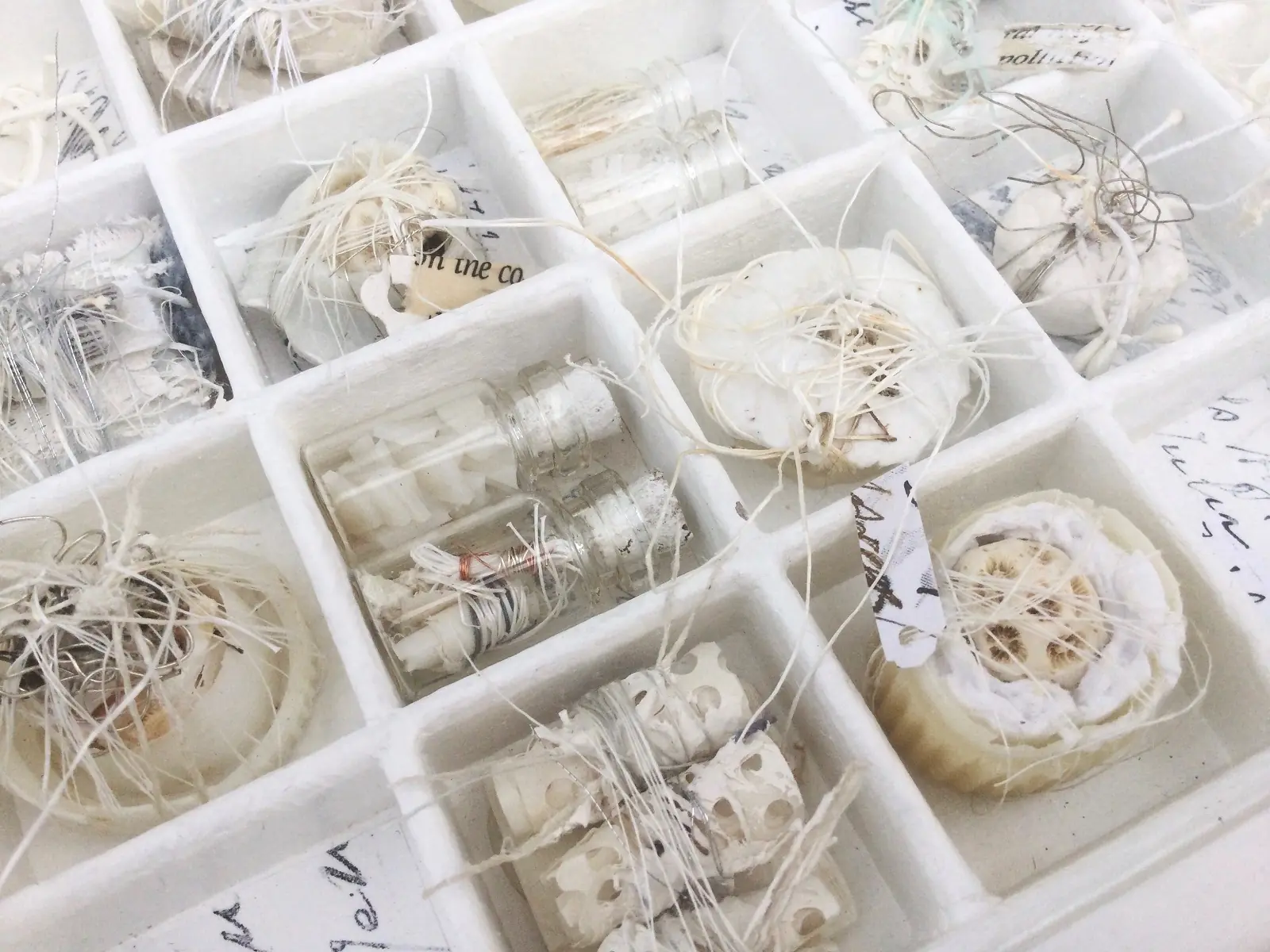
What currently inspires you?
I am currently inspired by the coast. I live about 10 minutes away from Morecambe Bay, so I often walk, sketch and collect there. However, when I can, I love to travel nationally and internationally and often head to the coast.
I am investigating discarded beach detritus, particularly plastic and the impact that has on marine life. I have been incorporating found plastics into my work for the last couple of years. I have been stitching into found plastic sheets or bags, as well as using discarded plastic rope and fishing line as thread.
I am also inspired by museum displays and collections, so I am presenting some of my work as if it would be viewed as a museum display case.
I have been presenting discarded plastic fragments found on the beach as though they are marine specimens in a museum display. I am alluding to the fact that if we continue to damage marine life with discarded plastic debris, the only specimens we will be able to see will be in museums.
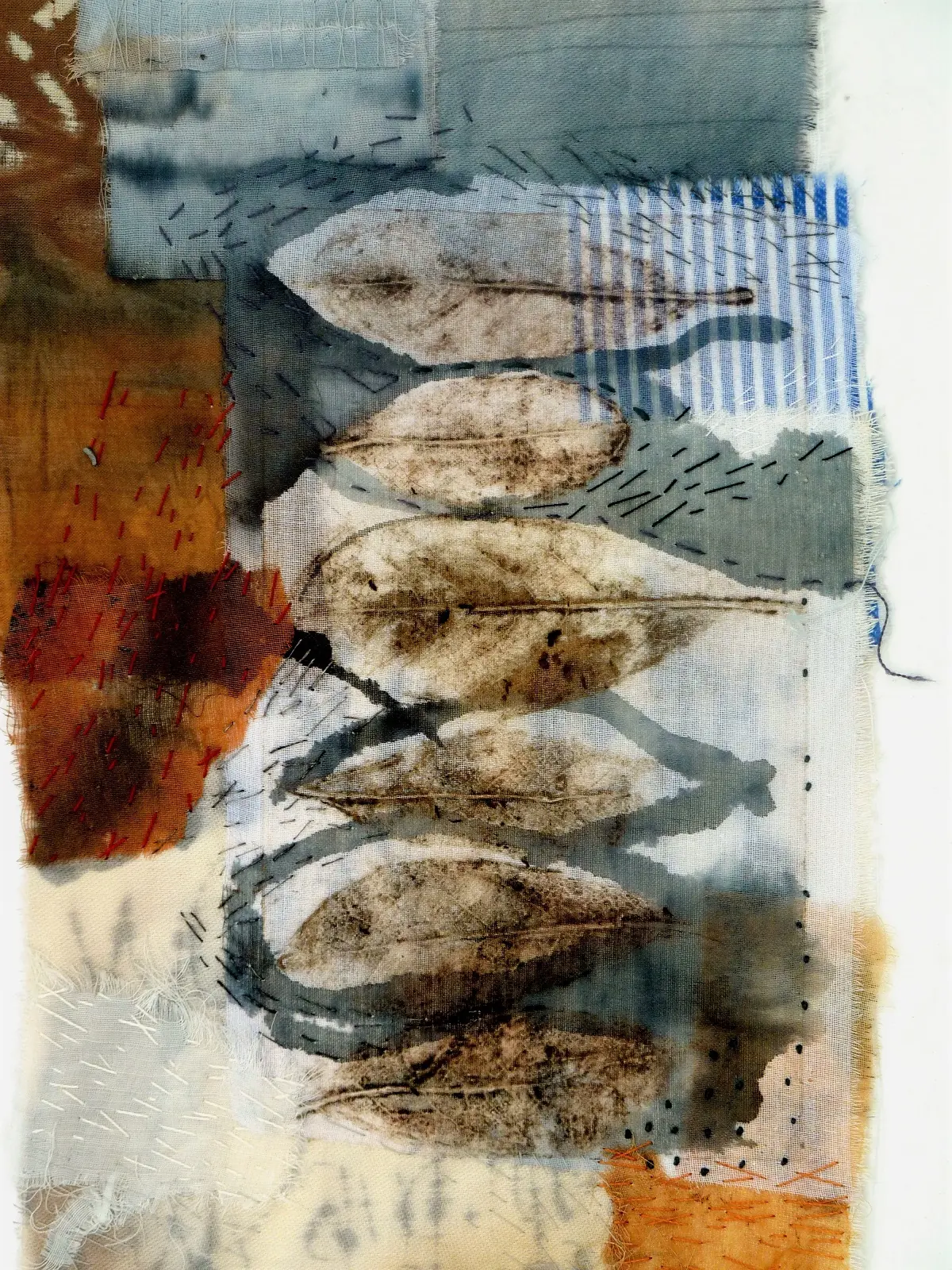
Layering is a constant
Tell us about a piece of your work that holds particularly fond memories and why?
In 2015, I made a series of work called ‘From Here to There.’ It comprised of 18 long, thin strips recording a series of walks shown alongside a box of fragments gathered on the walks. It was part of a collaborative exhibition between the Textile Study Group and a Swedish textile group called Textil13.
I was very fortunate to attend the private view at the Dalarna Museum in Falun with two fellow TSG members, Ruth Issett and Alison King.
The next day we went to Saterglantan (the Swedish School of Handicraft), so we could teach a 4-day workshop. It was a beautiful place. We stayed in wooden cabins in the forest working with the most lovely, talented students. It was a very special experience, and I have very fond memories.
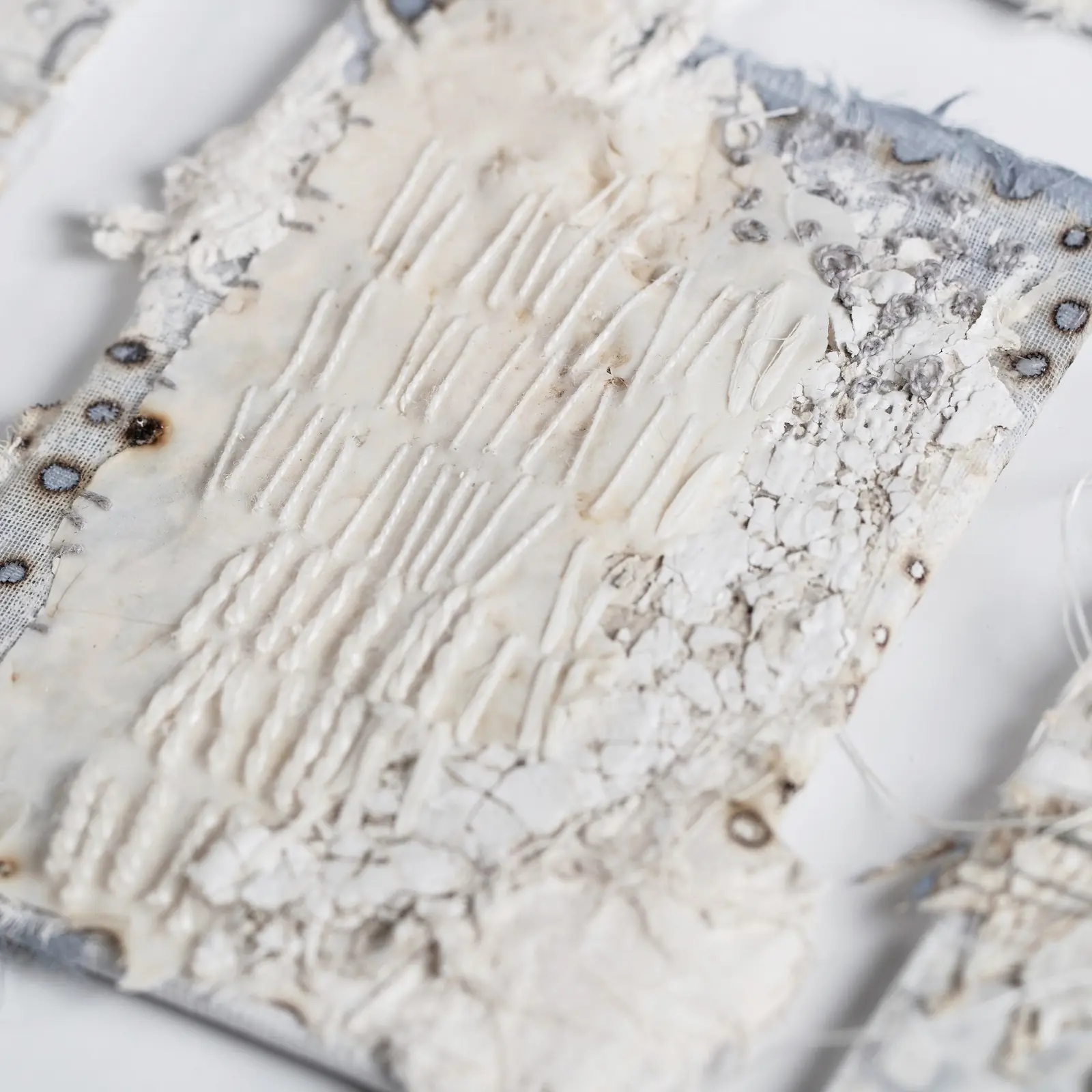
How has your work developed since you began and how do you see it evolving in the future?
I feel my work is constantly evolving. I have recently been making small models and assemblages, but after working this way for a while, I feel ready to go back to more stitched work. Often it is only when you look back at old work that you can see how much you have moved on.
My work has definitely evolved and developed since I began, but there are some underlying approaches and ways of working that continually come through in my work—layering, using and incorporating collections and the use of grids and individual units to make a whole.
I will continue to explore materials, and I always enjoy experimenting and exploring innovative ways of working.
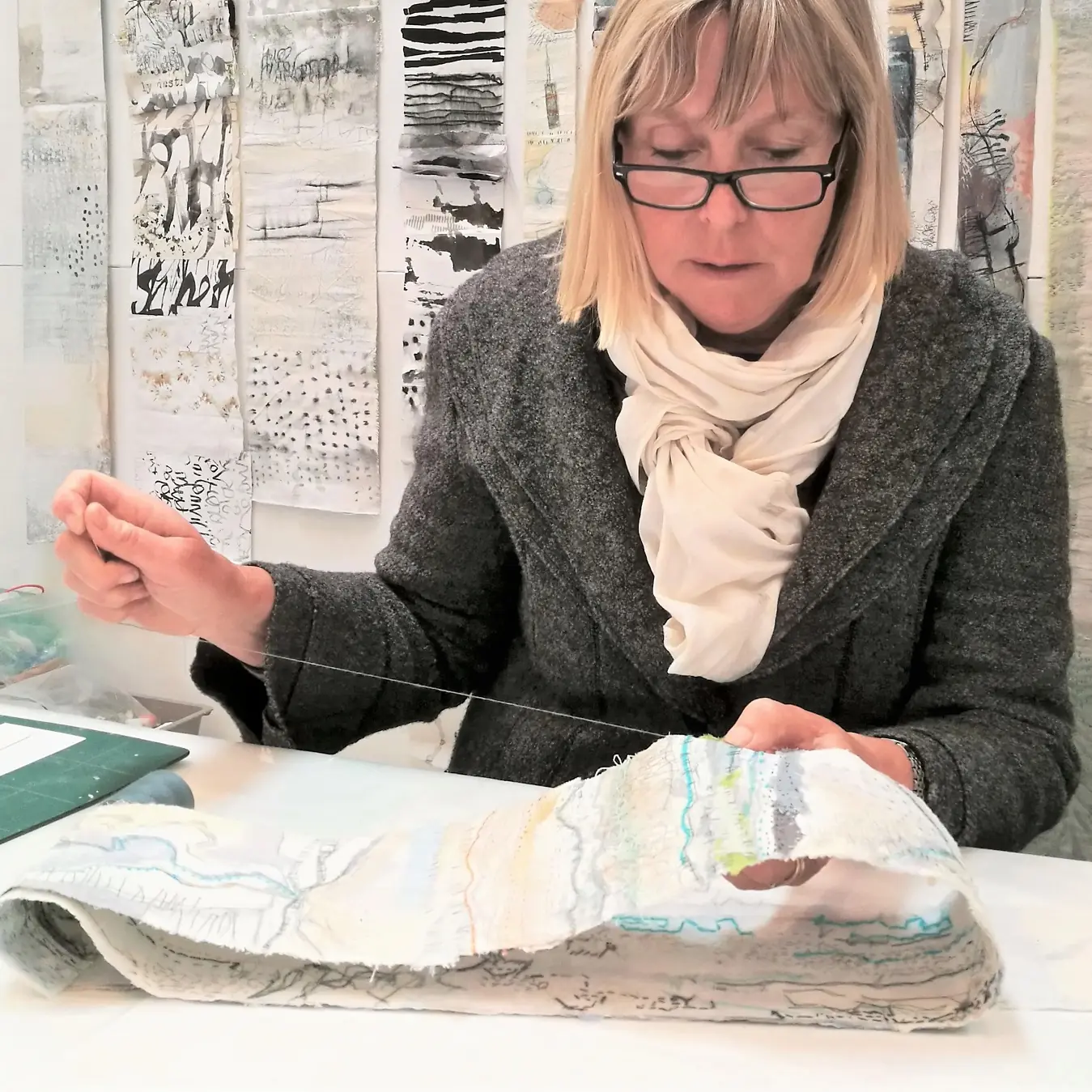
For more information visit www.shelleyrhodes.co.uk
Shelley purposely deconstructs materials before putting them together again. Have you done something similar in your own work? Let us know below.
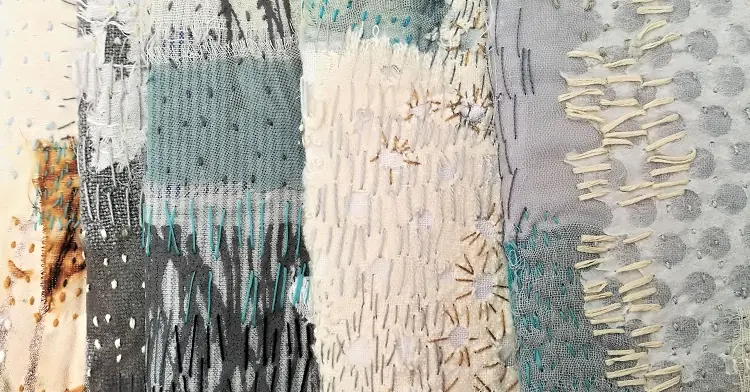
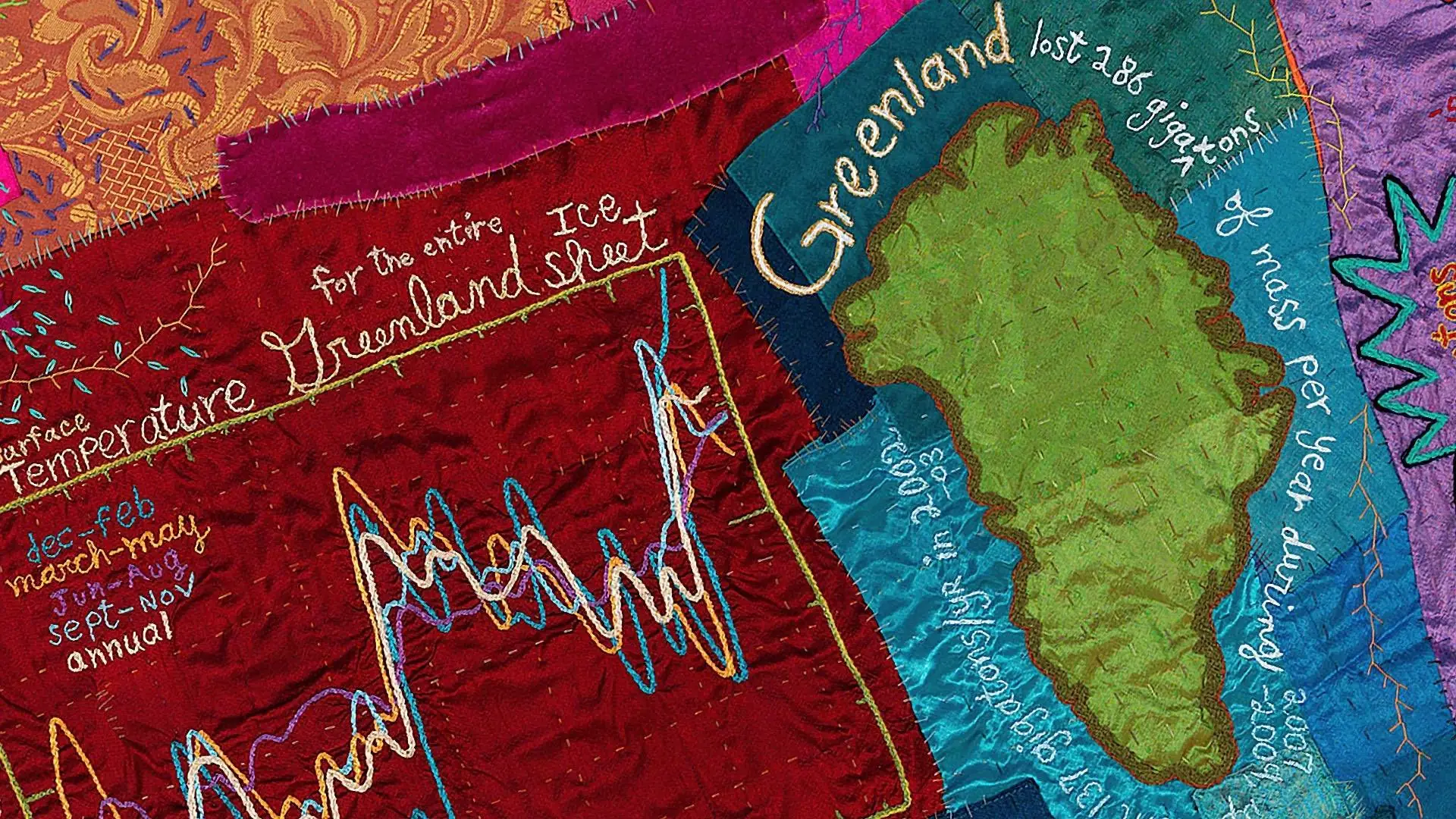
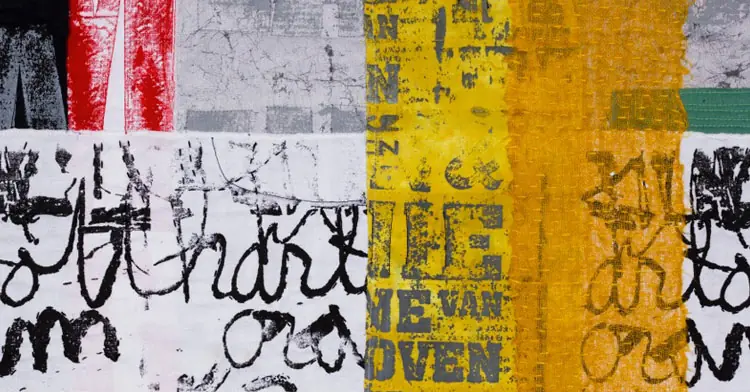
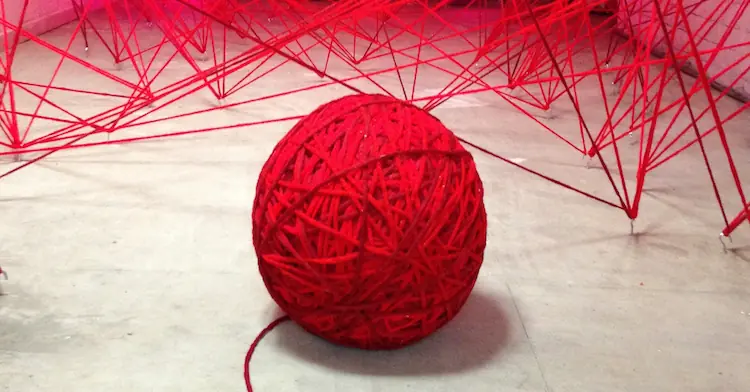
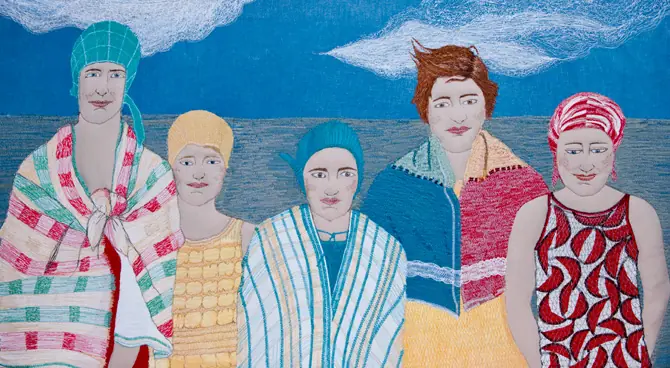
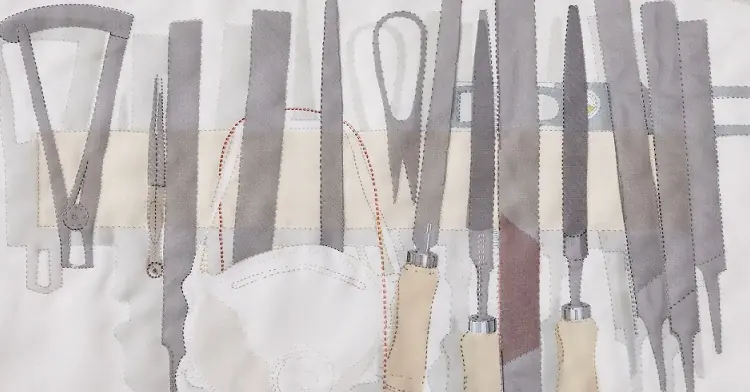
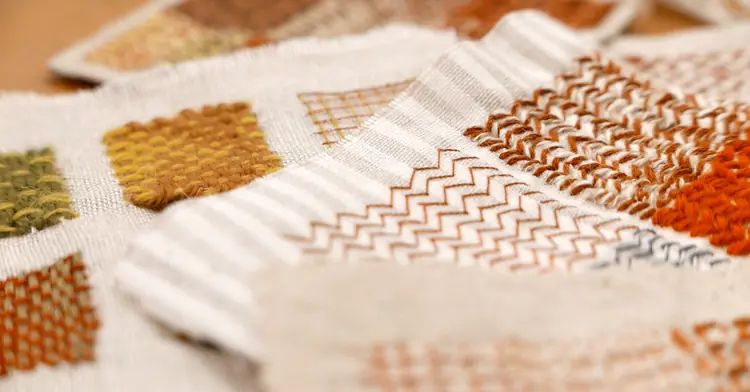
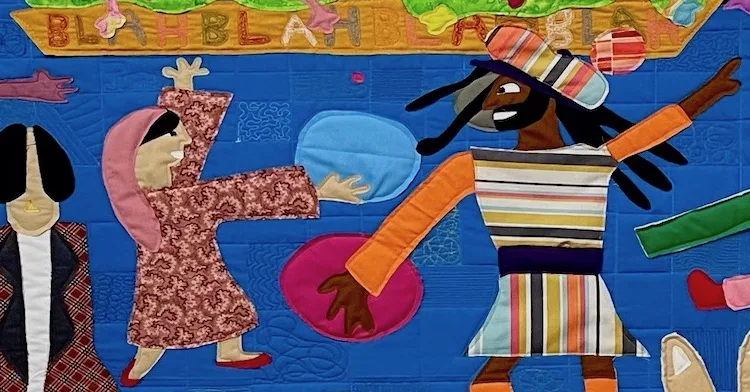
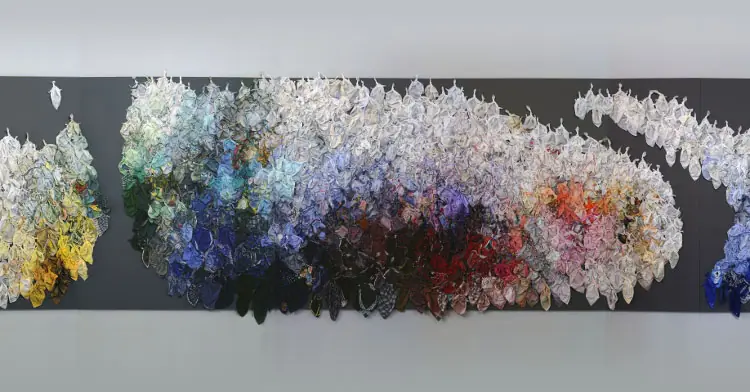
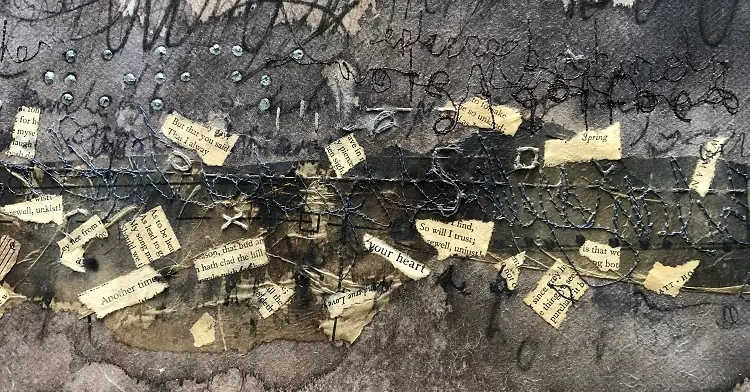
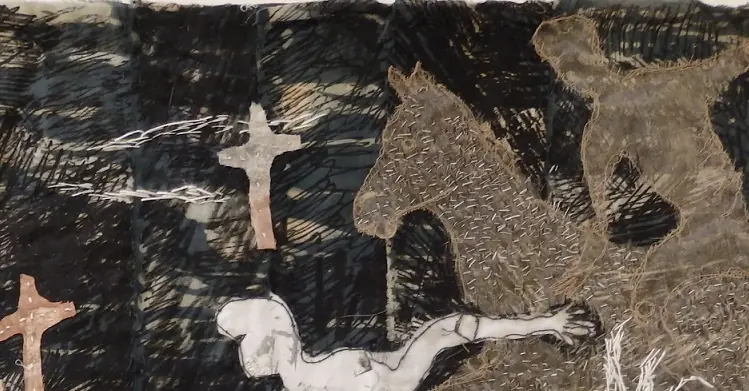
2 comments
Dina Osullivan
I love her work, the serendipity of it in an organized way. I am a felter and working on creating a senous pieces of felt in which I can stich b ack into using no fabrics and some fabrics that I plan to use dyes to create different patterns and colors for a larger piece of work.I have no idea how this will come out, but it is in my head. I like the way you use different t hreadsand different size stitches in your pieces. I am hoping to go for some short walks in wooded areas this Spring in Minnesota to find interesting sticks and other artifacts of nature. I would ike to hear back from you when you have the time. Your work has inspired me to do something differnt,Right now, I am working a bit on a gelli plae and trying to create images that aredimensional using layers of paint. Hope to hear from you Dina Osullivan
Daphne Panageas Britton
I’ve been obsessed with incorporating fabrics, plastics, recycled materials, broken figurines and cermics into my paintings for many years now… I am a schoolteacher.. I received my masters from BU in art education a year before I was forced to retire early due to an extremely rare inner ear condition SSCD… I am currently organizing my studio space, after one of many moves I’ve made in order to accommodate the loss of income due to my disabiling condition….